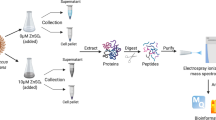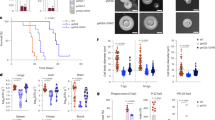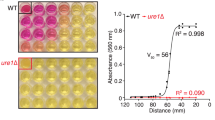Abstract
Cryptococcus is an opportunistic pathogen that lives in the environment as a free-living yeast and inflicts disease in humans, primarily in immunocompromised patients such as organ-transplant recipients and people with HIV/AIDS. A key factor allowing emergence of this fungal pathogen is a copper-containing laccase enzyme that facilitates nutrient foraging as a saprophyte and offers protection against environmental dangers such as free-living amoebae and mammalian macrophages during infection. The promiscuous substrate specificity of laccase facilitates the degradation of hard plant lignin polymers as well as the synthesis of lignin-like pigments from plant flavonoids and melanin pigments from dopamine. The enzyme also possesses an iron oxidase activity that prevents Fenton product formation in macrophages and another activity that allows synthesis of immune-modulatory prostaglandins that fool the host, shutting off an effective immune response. This review provides a brief overview of key points in laccase function and its role in virulence, as well as regulation and trafficking of the enzyme during the interconversion between saprophyte and pathogen, yielding insights into pathogenesis from this adaptable pathogen.


Similar content being viewed by others
References
Papers of particular interest, published recently, have been highlighted as: • Of importance •• Of major importance
Heitman J, and American Society for Microbiology. Cryptococcus: from human pathogen to model yeast. 2011. Washington, DC: ASM Press. xvii, 620.
National Center for Zoonotic, V-B, and Enteric Diseases. Cryptococcus (Cryptococcosis). 2010; CDC website detailing general information for Cryptococcosis]. Available from: http://www.cdc.gov/nczved/divisions/dfbmd/diseases/cryptococcus/index.html#top.
Li SS, Mody CH. Cryptococcus. Proc Am Thorac Soc. 2010;7(3):186–96.
Park BJ et al. Estimation of the current global burden of cryptococcal meningitis among persons living with HIV/AIDS. AIDS. 2009;23(4):525–30.
Diamond RD, Bennett JE. Prognostic factors in cryptococcal meningitis. A study in 111 cases. Ann Intern Med. 1974;80(2):176–81.
Olszewski MA, Zhang Y, Huffnagle GB. Mechanisms of cryptococcal virulence and persistence. Future Microbiol. 2010;5(8):1269–88.
Sanfelice F. Contributo alla morfolgia e biologia dei blastomiceti che si sviluppano nei succhi de alcuni frutti. Ann Igien. 1894;4:463–95.
Ruiz A, Fromtling RA, Bulmer GS. Distribution of Cryptococcus neoformans in a natural site. Infect Immun. 1981;31(2):560–3.
Garcia-Hermoso D, Janbon G, Dromer F. Epidemiological evidence for dormant Cryptococcus neoformans infection. J Clin Microbiol. 1999;37(10):3204–9.
Lundell TK, Makela MR, Hilden K. Lignin-modifying enzymes in filamentous basidiomycetes–ecological, functional and phylogenetic review. J Basic Microbiol. 2010;50(1):5–20.
Zhu X, Williamson PR. Role of laccase in the biology and virulence of Cryptococcus neoformans. FEMS Yeast Res. 2004;5(1):1–10.
Chang YC et al. Cryptococcal yeast cells invade the central nervous system via transcellular penetration of the blood-brain barrier. Infect Immun. 2004;72(9):4985–95.
Eisenman HC, Casadevall A, McClelland EE. New insights on the pathogenesis of invasive Cryptococcus neoformans infection. Curr Infect Dis Rep. 2007;9(6):457–64.
Waterman SR et al. Cell wall targeting of laccase of Cryptococcus neoformans during infection of mice. Infect Immun. 2007;75(2):714–22.
Cox GM et al. Urease as a virulence factor in experimental cryptococcosis. Infect Immun. 2000;68(2):443–8.
•• Panepinto J, et al. Sec6-dependent sorting of fungal extracellular exosomes and laccase of Cryptococcus neoformans. Mol Microbiol. 2009;71(5):1165–76. The presence of extracellular vesicles and their dependence on Sec6-dependent secretion provided the first molecular proof of exosome formation in fungi.
•• Chayakulkeeree M, et al. SEC14 is a specific requirement for secretion of phospholipase B1 and pathogenicity of Cryptococcus neoformans. Mol Microbiol. 2011;80(4):1088–101. This paper shows differential sorting of the virulence factor, laccase, and another virulence factor, phospholipase B1, demonstrating that different virulence factors can be transported by distinct pathways.
Hu G et al. PI3K signaling of autophagy is required for starvation tolerance and virulenceof Cryptococcus neoformans. J Clin Invest. 2008;118(3):1186–97.
Liu L, Tewari RP, Williamson PR. Laccase protects Cryptococcus neoformans from antifungal activity of alveolar macrophages. Infect Immun. 1999;67(11):6034–9.
Shea JM, Del Poeta M. Lipid signaling in pathogenic fungi. Curr Opin Microbiol. 2006;9(4):352–8.
Thurston CF. The structure and function of fungal laccases. Microbiology. 1994;140(1):19–26.
Mayer AM, Staples RC. Laccase: new functions for an old enzyme. Phytochemistry. 2002;60(6):551–65.
Brijwani K, Rigdon A, Vadlani PV. Fungal laccases: production, function, and applications in food processing. Enzyme Res. 2010;2010:149748.
Giardina P et al. Laccases: a never-ending story. Cell Mol Life Sci. 2010;67(3):369–85.
Fowler ZL et al. Melanization of flavonoids by fungal and bacterial laccases. Yeast. 2011;28(3):181–8.
Williamson PR. Biochemical and molecular characterization of the diphenol oxidase of Cryptococcus neoformans: identification as a laccase. J Bacteriol. 1994;176(3):656–64.
Zhao Q, Dixon RA. Transcriptional networks for lignin biosynthesis: more complex than we thought? Trends Plant Sci. 2011;16(4):227–33.
Leonowicz A et al. Fungal laccase: properties and activity on lignin. J Basic Microbiol. 2001;41(3–4):185–227.
Eggert C. Laccase-catalyzed formation of cinnabarinic acid is responsible for antibacterial activity of Pycnoporus cinnabarinus. Microbiol Res. 1997;152(3):315–8.
Perry CR et al. The structure of laccase protein and its synthesis by the commercial mushroom Agaricus bisporus. J Gen Microbiol. 1993;139(1):171–8.
Bertrand T et al. Crystal structure of a four-copper laccase complexed with an arylamine: insights into substrate recognition and correlation with kinetics. Biochemistry. 2002;41(23):7325–33.
Hakulinen N et al. Crystal structure of a laccase from Melanocarpus albomyces with an intact trinuclear copper site. Nat Struct Biol. 2002;9(8):601–5.
Mylonakis E et al. Killing of Caenorhabditis elegans by Cryptococcus neoformans as a model of yeast pathogenesis. Proc Natl Acad Sci USA. 2002;99(24):15675–80.
Walton FJ, Idnurm A, Heitman J. Novel gene functions required for melanization of the human pathogen Cryptococcus neoformans. Mol Microbiol. 2005;57(5):1381–96.
Pukkila-Worley R et al. Transcriptional network of multiple capsule and melanin genes governed by the Cryptococcus neoformans cyclic AMP cascade. Eukaryot Cell. 2005;4(1):190–201.
Salas SD et al. Effect of the laccase gene CNLAC1, on virulence of Cryptococcus neoformans. J Exp Med. 1996;184(2):377–86.
Eisenman HC et al. Cryptococcus neoformans laccase catalyses melanin synthesis from both D- and L-DOPA. Microbiology. 2007;153(Pt 12):3954–62.
Williamson PR. Laccase and melanin in the pathogenesis of Cryptococcus neoformans. Front Biosci. 1997;2:e99–107.
Lerch K, Germann UA. Evolutionary relationships among copper proteins containing coupled binuclear copper sites. Prog Clin Biol Res. 1988;274:331–48.
Ito S, Kato T, Fujita K. Covalent binding of catechols to proteins through the sulphydryl group. Biochem Pharmacol. 1988;37(9):1707–10.
Riley PA. Melanin. Int J Biochem Cell Biol. 1997;29(11):1235–9.
Sharma S, Wagh S, Govindarajan R. Melanosomal proteins–role in melanin polymerization. Pigment Cell Res. 2002;15(2):127–33.
Wagh S et al. Melanosomal proteins promote melanin polymerization. Pigment Cell Res. 2000;13(6):442–8.
Sidjanski S, Mathews GV, Vanderberg JP. Electrophoretic separation and identification of phenoloxidases in hemolymph and midgut of adult Anopheles stephensi mosquitoes. J Parasitol. 1997;83(4):686–91.
Staib F, Senska M. Brown pigmentation (brown colour effect, BCE) of Cryptococcus neoformans on Guizotia abyssinica-creatinine-agar as dependent on the initial pH value (author’s transl). Zentralbl Bakteriol Orig A. 1973;225(1):113–24.
Kwon-Chung KJ, Bennett JE. Medical mycology. Philadelphia: Lea & Febiger. ix; 1992. p. 866.
Fleet GH. Yeast interactions and wine flavour. Int J Food Microbiol. 2003;86(1–2):11–22.
Kwon-Chung KJ, Polacheck I, Popkin TJ. Melanin-lacking mutants of Cryptococcus neoformans and their virulence for mice. J Bacteriol. 1982;150(3):1414–21.
Loftus BJ et al. The genome of the basidiomycetous yeast and human pathogen Cryptococcus neoformans. Science. 2005;307(5713):1321–4.
Nosanchuk JD et al. Melanization of Cryptococcus neoformans in murine infection. Mol Cell Biol. 1999;19(1):745–50.
Nosanchuk JD et al. Evidence that Cryptococcus neoformans is melanized in pigeon excreta: implications for pathogenesis. Infect Immun. 1999;67(10):5477–9.
Eisenman HC et al. Vesicle-associated melanization in Cryptococcus neoformans. Microbiology. 2009;155(Pt 12):3860–7.
Perfect JR et al. Clinical practice guidelines for the management of cryptococcal disease: 2010 update by the Infectious Diseases Society of America. Clin Infect Dis. 2010;50(3):291–322.
Te Dorsthorst DT et al. In vitro interaction of flucytosine combined with amphotericin B or fluconazole against thirty-five yeast isolates determined by both the fractional inhibitory concentration index and the response surface approach. Antimicrob Agents Chemother. 2002;46(9):2982–9.
Hastings TG. The role of dopamine oxidation in mitochondrial dysfunction: implications for Parkinson’s disease. J Bioenerg Biomembr. 2009;41(6):469–72.
Nyhus KJ, Wilborn AT, Jacobson ES. Ferric iron reduction by Cryptococcus neoformans. Infect Immun. 1997;65(2):434–8.
Howard DH. Acquisition, transport, and storage of iron by pathogenic fungi. Clin Microbiol Rev. 1999;12(3):394–404.
Zhu X et al. Laccase of Cryptococcus neoformans is a cell wall-associated virulence factor. Infect Immun. 2001;69(9):5589–96.
Sargent PJ, Farnaud S, Evans RW. Structure/function overview of proteins involved in iron storage and transport. Curr Med Chem. 2005;12(23):2683–93.
Erb-Downward JR et al. The role of laccase in prostaglandin production by Cryptococcus neoformans. Mol Microbiol. 2008;68(6):1428–37.
Naito Y. Molecular mechanism of cytokine gene expression in Th1 and Th2. Rinsho Byori. 1998;46(9):900–7.
Stashenko P, Teles R, D’Souza R. Periapical inflammatory responses and their modulation. Crit Rev Oral Biol Med. 1998;9(4):498–521.
Noverr MC et al. Pathogenic yeasts Cryptococcus neoformans and Candida albicans produce immunomodulatory prostaglandins. Infect Immun. 2001;69(5):2957–63.
Erb-Downward JR, Huffnagle GB. Cryptococcus neoformans produces authentic prostaglandin E2 without a cyclooxygenase. Eukaryot Cell. 2007;6(2):346–50.
Jiang N et al. Negative roles of a novel nitrogen metabolite repression-related gene, TAR1, in laccase production and nitrate utilization by the basidiomycete Cryptococcus neoformans. Appl Environ Microbiol. 2009;75(21):6777–82.
Bahn YS et al. Adenylyl cyclase-associated protein Aca1 regulates virulence and differentiation of Cryptococcus neoformans via the cyclic AMP-protein kinase A cascade. Eukaryot Cell. 2004;3(6):1476–91.
Heung LJ et al. The role and mechanism of diacylglycerol-protein kinase C1 signaling in melanogenesis by Cryptococcus neoformans. J Biol Chem. 2005;280(31):28547–55.
Heung LJ et al. The sphingolipid pathway regulates Pkc1 through the formation of diacylglycerol in Cryptococcus neoformans. J Biol Chem. 2004;279(20):21144–53.
Jiang N et al. A copper-responsive factor gene CUF1 is required for copper induction of laccase in Cryptococcus neoformans. FEMS Microbiol Lett. 2009;296(1):84–90.
Jung WH et al. Iron regulation of the major virulence factors in the AIDS-associated pathogen Cryptococcus neoformans. PLoS Biol. 2006;4(12):e410.
Nyhus K, Jacobson ES. Oxy2 as a transcriptional activator gene for copper uptake in Cryptococcus neoformans. Med Mycol. 2004;42(4):325–31.
Rhome R, Del Poeta M. Lipid signaling in pathogenic fungi. Annu Rev Microbiol. 2009;63:119–31.
D’Souza CA, Heitman J. Conserved cAMP signaling cascades regulate fungal development and virulence. FEMS Microbiol Rev. 2001;25(3):349–64.
Idnurm A et al. Deciphering the model pathogenic fungus Cryptococcus neoformans. Nat Rev Microbiol. 2005;3(10):753–64.
Maeng S et al. Comparative transcriptome analysis reveals novel roles of the Ras and cyclic AMP signaling pathways in environmental stress response and antifungal drug sensitivity in Cryptococcus neoformans. Eukaryot Cell. 2010;9(3):360–78.
Fan W et al. Cryptococcus neoformans gene expression during murine macrophage infection. Eukaryot Cell. 2005;4(8):1420–33.
Griffioen G, Thevelein JM. Molecular mechanisms controlling the localisation of protein kinase A. Curr Genet. 2002;41(4):199–207.
Scott JD. Dissection of protein kinase and phosphatase targeting interactions. Soc Gen Physiol Ser. 1997;52:227–39.
Thevelein JM. The RAS-adenylate cyclase pathway and cell cycle control in Saccharomyces cerevisiae. Antonie Van Leeuwenhoek. 1992;62(1–2):109–30.
Yvert G et al. Trans-acting regulatory variation in Saccharomyces cerevisiae and the role of transcription factors. Nat Genet. 2003;35(1):57–64.
Chang YC, Kwon-Chung KJ. Complementation of a capsule-deficient mutation of Cryptococcus neoformans restores its virulence. Mol Cell Biol. 1994;14(7):4912–9.
Alspaugh JA et al. Adenylyl cyclase functions downstream of the Galpha protein Gpa1 and controls mating and pathogenicity of Cryptococcus neoformans. Eukaryot Cell. 2002;1(1):75–84.
D’Souza CA et al. Cyclic AMP-dependent protein kinase controls virulence of the fungal pathogen Cryptococcus neoformans. Mol Cell Biol. 2001;21(9):3179–91.
Hu G et al. Transcriptional regulation by protein kinase A in Cryptococcus neoformans. PLoS Pathog. 2007;3(3):e42.
Kwon-Chung KJ, Edman JC, Wickes BL. Genetic association of mating types and virulence in Cryptococcus neoformans. Infect Immun. 1992;60(2):602–5.
Chang YC, Penoyer LA, Kwon-Chung KJ. The second STE12 homologue of Cryptococcus neoformans is MATa-specific and plays an important role in virulence. Proc Natl Acad Sci USA. 2001;98(6):3258–63.
Chang YC et al. Cryptococcus neoformans STE12alpha regulates virulence but is not essential for mating. J Exp Med. 2000;191(5):871–82.
Wickes BL, Edman U, Edman JC. The Cryptococcus neoformans STE12alpha gene: a putative Saccharomyces cerevisiae STE12 homologue that is mating type specific. Mol Microbiol. 1997;26(5):951–60.
Dromer F et al. Molecular ty** of Cryptococcus neoformans serotype D clinical isolates. J Clin Microbiol. 1994;32(10):2364–71.
Lin X et al. Impact of mating type, serotype, and ploidy on the virulence of Cryptococcus neoformans. Infect Immun. 2008;76(7):2923–38.
Huffnagle GB, Casadevall A, Perfect JR. Cryptococcus neoformans [book review]. Mycopathologia. 1999;147(1):59–60.
Bahn YS et al. Specialization of the HOG pathway and its impact on differentiation and virulence of Cryptococcus neoformans. Mol Biol Cell. 2005;16(5):2285–300.
Park YD et al. Mating pheromone in Cryptococcus neoformans is regulated by a transcriptional/degradative “futile” cycle. J Biol Chem. 2010;285(45):34746–56.
Panepinto J et al. The DEAD-box RNA helicase Vad1 regulates multiple virulence-associated genes in Cryptococcus neoformans. J Clin Invest. 2005;115(3):632–41.
Luberto C et al. Roles for inositol-phosphoryl ceramide synthase 1 (IPC1) in pathogenesis of C. neoformans. Genes Dev. 2001;15(2):201–12.
Patki V et al. Identification of an early endosomal protein regulated by phosphatidylinositol 3-kinase. Proc Natl Acad Sci USA. 1997;94(14):7326–30.
Rivier AS et al. Exit of GPI-anchored proteins from the ER differs in yeast and mammalian cells. Traffic. 2010;11(8):1017–33.
Segev N. Coordination of intracellular transport steps by GTPases. Semin Cell Dev Biol. 2011;22(1):33–8.
Chen SH et al. Ypt31/32 GTPases and their novel F-box effector protein Rcy1 regulate protein recycling. Mol Biol Cell. 2005;16(1):178–92.
Erickson T et al. Multiple virulence factors of Cryptococcus neoformans are dependent on VPH1. Mol Microbiol. 2001;42(4):1121–31.
Hsu SC et al. Targeting vesicles to specific sites on the plasma membrane: the role of the sec6/8 complex. Trends Cell Biol. 1999;9(4):150–3.
Rodrigues ML et al. Vesicular trans-cell wall transport in fungi: a mechanism for the delivery of virulence-associated macromolecules? Lipid Insights. 2008;2:27–40.
Rodrigues ML et al. Vesicular polysaccharide export in Cryptococcus neoformans is a eukaryotic solution to the problem of fungal trans-cell wall transport. Eukaryot Cell. 2007;6(1):48–59.
Yoneda A, Doering TL. An unusual organelle in Cryptococcus neoformans links luminal pH and capsule biosynthesis. Fungal Genet Biol. 2009;46(9):682–7.
Oliveira DL et al. Characterization of yeast extracellular vesicles: evidence for the participation of different pathways of cellular traffic in vesicle biogenesis. PLoS One. 2010;5(6):e11113.
Piper RC, Katzmann DJ. Biogenesis and function of multivesicular bodies. Annu Rev Cell Dev Biol. 2007;23:519–47.
Tommasino N et al. Atf2 transcription factor binds to the APP1 promoter in Cryptococcus neoformans: stimulatory effect of diacylglycerol. Eukaryot Cell. 2008;7(2):294–301.
Adler A et al. A novel specificity protein 1 (SP1)-like gene regulating protein kinase C-1 (Pkc1)-dependent cell wall integrity and virulence factors in Cryptococcus neoformans. J Biol Chem. 2011;286(23):20977–90.
Shen G et al. Pleiotropic function of intersectin homologue Cin1 in Cryptococcus neoformans. Mol Microbiol. 2010;76(3):662–76.
Acknowledgment
This work was supported by the Intramural Research Program of the National Institutes of Health, National Institute of Allergy and Infectious Diseases.
Disclosure
No potential conflicts of interest relevant to this article were reported.
Author information
Authors and Affiliations
Corresponding author
Rights and permissions
About this article
Cite this article
Chen, S.H., Williamson, P.R. Lessons from Cryptococcal Laccase: From Environmental Saprophyte to Pathogen. Curr Fungal Infect Rep 5, 233–244 (2011). https://doi.org/10.1007/s12281-011-0069-3
Published:
Issue Date:
DOI: https://doi.org/10.1007/s12281-011-0069-3
Keywords
- Cryptococcus
- Laccase
- Opportunistic pathogen
- Cryptococcosis
- Yeast
- Fungus
- Melanin
- Iron oxidase
- Prostaglandin
- Copper
- Macrophage
- Quinone
- Lignin
- Virulence
- Sphingolipid
- Protein trafficking
- Central nervous system
- Phagocytosis
- Meningoencephalitis
- Cyclooxygenase
- Adenyl cyclase
- Cyclic AMP
- Inositol-phosphoryl ceramide synthase
- Diacylglycerol




